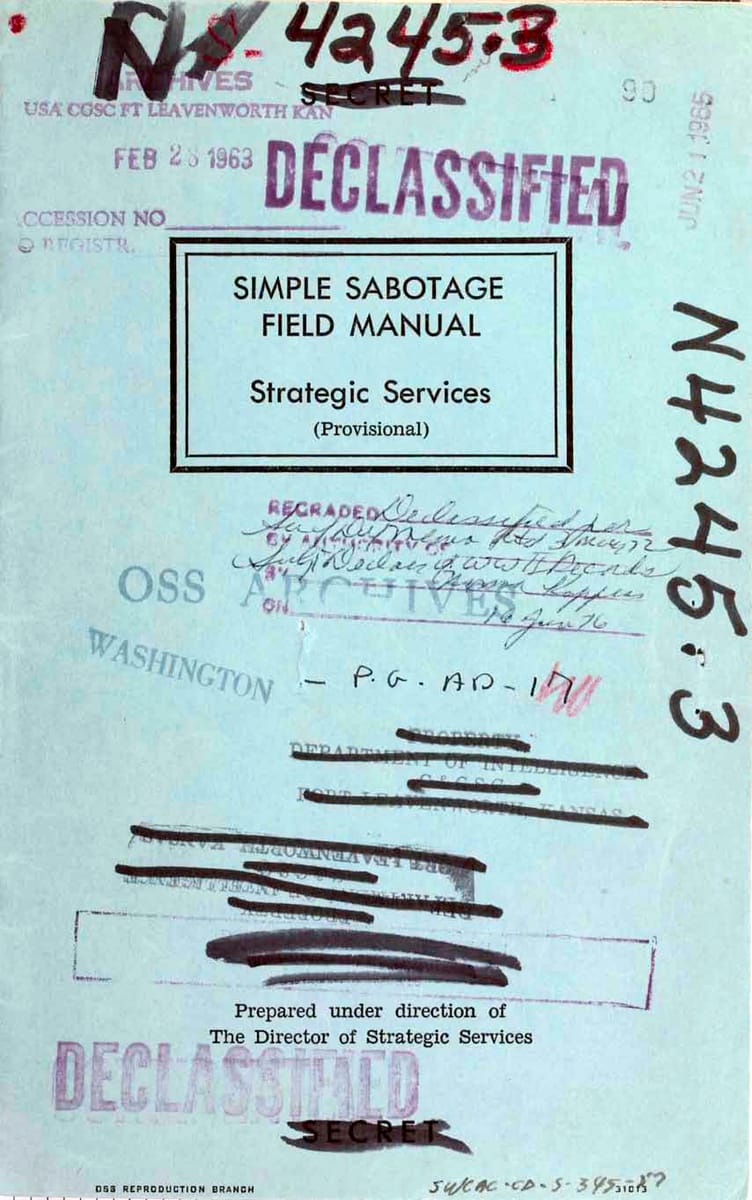- History Investor
- Posts
- Simple Sabotage Field Manual - How to Destroy Your Organizations
Simple Sabotage Field Manual - How to Destroy Your Organizations
"The purpose of this paper is to characterize simple sabotage, to outline its possible effects, and to present suggestions for inciting and executing it."

Welcome to all our new subscribers! If you enjoy the newsletter, please forward this along to one or more friends/colleagues or click here to share on Twitter to help us grow!
History of the Simple Sabotage Field Manual
Before the CIA, there was the OSS - the Office of Strategic Services.
Formed in 1942 in order to shore up American intelligence capabilities at the request of Franklin D. Roosevelt, before the end of WWII the OSS eventually employed ~24,000 people and had operations across Europe and Asia. Amongst its responsibilities was frustrating the German war effort, and to that end, it wrote a short set of “best practices” - the Simple Sabotage Field Manual.
The purpose of the manual is fairly straightforward - it is to…
…characterize simple sabotage, to outline its possible effects, and to present suggestions for inciting and executing it.
Sabotage varies from highly technical coup de main acts that require detailed planning and the use of specially trained operatives, to innumnerable simple acts which the ordinary individual citizen-saboteur can perform. This paper is primarily concerned with the latter type….
Simple sabotage requires no destructive tools whatsoever and produces physical damage, if any, by highly indirect means. It is based on universal opportunities to make faulty decisions, to adopt a non-cooperative attitude, and to induce others to follow suit. Making a faulty decision may be simply a matter of placing tools in one spot instead of another. A non-cooperative attitude may involve nothing more than creating an unpleasant situation among one’s fellow workers, engaging in bickerings, or displaying surliness and stupidity.
This type of activity, sometimes referred to as the “human element," is frequently responsible for accidents, delays, and general obstruction even under normal conditions. The potential saboteur should discover what types of faulty decisions and cooperation are normally found in this kind of work and should then devise his sabotage so as to enlarge that “margin for error."
The manual, published in 1944, has now been declassified - but it was once used as a reference guide for OSS operatives globally to train individuals in German-occupied territories how to best become “citizen saboteurs.” It says that “purposeful stupidity is contrary to human nature” and thus the manual means to serve as inspiration and direction for saboteurs.
In short, the best way that ordinary citizens, unhappy with the German occupation, could aid the Allied military was to drive inefficiency in their workplaces - to slow down every attempt at progress and make even the simplest tasks frustrating.
Specific examples involved mechanics not repairing engines on time, misplacing tools so that they are hard to find, or misusing tools so as to break them more frequently. Bus drivers could “accidentally” go past the bus stops where German officers would most likely be found or want to get off. Train operators could issue the wrong tickets to travelers so they end up at the wrong destination, or they could issue two tickets for the same seat to cause delays. Janitors could ensure a disorderly workplace environment by keeping things dirty or placing rice in water cooling systems. Even those without jobs could get involved - by giving wrong directions when asked, changing signposts to point the wrong way, or pretending to not speak whatever language the other person is using.
How to Sabotage Your Team Most Effectively
This all got me thinking about Charlie Munger, and how he has said it is often easier to solve problems backwards than it is to solve them forwards - try to uncover the things that would most effectively prevent you from achieving your goals and just don’t do those things - avoid what is certain to bring about failure so that you give yourself the best shot at success.
Reply